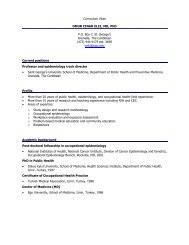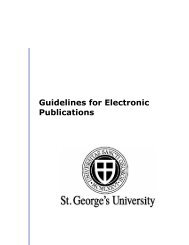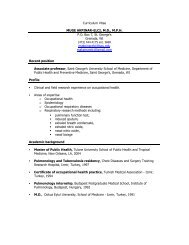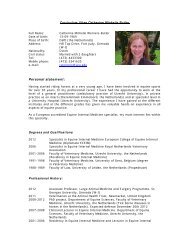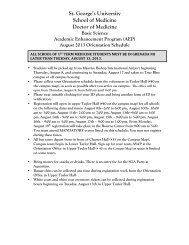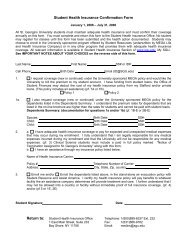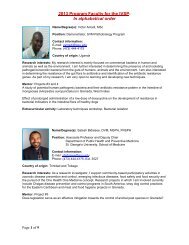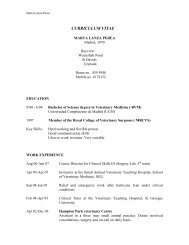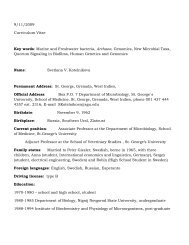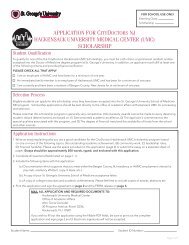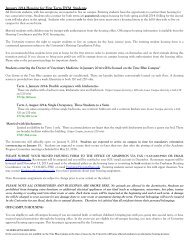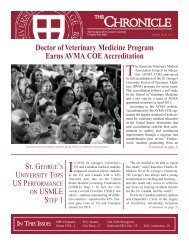SCHOOL OF 2012-2013 - St. George's University
SCHOOL OF 2012-2013 - St. George's University
SCHOOL OF 2012-2013 - St. George's University
You also want an ePaper? Increase the reach of your titles
YUMPU automatically turns print PDFs into web optimized ePapers that Google loves.
School of Medicine<br />
Course Descriptions<br />
literature, and computer applications are used to familiarize<br />
students with public research methods in public health.<br />
PUBH 835<br />
Practical Data Management and Analysis<br />
In this course, students will learn the concepts and practice<br />
of sound data management, data editing, and cleaning, as<br />
well as plan and conduct an analysis of actual public health<br />
data. <strong>St</strong>udents will use Epi Info to create data entry screens<br />
and edits, enter and clean data they have collected, and<br />
analyze data from a large cross-sectional survey, in addition<br />
to an analytic epidemiologic cohort or case-control study.<br />
The knowledge and skills acquired in this course will be<br />
useful for anyone whose future plans include epidemiology,<br />
biostatistics, or medical or veterinary research.<br />
PUBH 837<br />
Environmental Sustainable Development<br />
Principle I of the Rio Declaration on Environment and<br />
Development (1992) states, “Human beings are at the<br />
center of concerns for sustainable development. They are<br />
entitled to a healthy and productive life in harmony with<br />
nature.” The objectives of this course are to introduce<br />
students to the definition and concepts of sustainable<br />
development, and to explore the cross-cutting relationship<br />
between health and sustainable development. The areas<br />
of focus include energy for sustainable development,<br />
atmospheric pollution and climate change, integrated<br />
water resources management, integrated solid waste<br />
management, health and sustainable development,<br />
disaster reduction and management, biodiversity, trade<br />
and environment, sustainable consumption and production,<br />
sustainable tourism, agriculture, transport, human<br />
settlements, international law, industrial development,<br />
poverty, and national sustainable development strategies.<br />
PUBH 841<br />
Occupational and Environmental Epidemiology<br />
The main goal of this course is to provide an introduction<br />
to environmental and occupational epidemiology and<br />
basic concepts, methodology, and practical usage in public<br />
health. This course describes epidemiological methods<br />
that are utilized to study risk factors in occupational and<br />
environmental health. <strong>St</strong>udents will critically analyze<br />
epidemiological studies in occupational and environmental<br />
health settings. <strong>St</strong>udents will gain knowledge and skills to<br />
evaluate environmental and occupational health problems<br />
by using epidemiologic methodology.<br />
PUBH 842<br />
Intermediate Epidemiology<br />
In this course, students will be exposed to a more in-depth<br />
look at basic study designs, including the measures of<br />
disease occurrence, measure of effect, and the concept<br />
of validity and methods to deal with threats to validity, as<br />
well as defining and assessing heterogeneity. This course<br />
will also expose students to the most common analytic<br />
methods used by epidemiologists.<br />
PUBH 843<br />
Infectious Diseases Epidemiology<br />
During the first half of this course, students are introduced<br />
to basic epidemiological concepts and methods, which<br />
form part of the standard armament of all epidemiologic<br />
activity. This includes the most common measures of<br />
disease frequency, measures of effect, basic study designs,<br />
concepts of validity, and basic statistical concepts. In the<br />
second part of the course, emphasis is placed on how<br />
these basic tools are applied in the disease dependence<br />
context typical of infectious disease epidemiology. In<br />
this part of the course, students will look at models for<br />
epidemics, outbreak investigation and analysis, surveillance,<br />
measurement of infectivity, contact patterns, and the<br />
epidemiology of vaccination. During this part of the course,<br />
an effort will be made to demonstrate the application<br />
of these methods in the context of important infectious<br />
diseases of human, animal, and zoonotic origin.<br />
PUBH 844<br />
Decision Making for Public Health Policy<br />
This course is all about “doing the right things right.” It<br />
gives an overview of different techniques for decision<br />
making in health policy and management. Decision<br />
making is an essential part of working as a public health<br />
professional; it forms the critical link between theory and<br />
practice, and thus assures implementation of the right<br />
interventions with the maximum impact on the well-being<br />
of the population or groups of patients.<br />
PUBH 847<br />
Water Resources Management<br />
This course is designed to build upon the knowledge<br />
gained in Introduction to Environmental Health (PUBH<br />
807). <strong>St</strong>udents will gain a basic understanding of watershed<br />
hydrology and water supply as well as the physical and<br />
social causes and public health significance of water<br />
stress and water scarcity. Additionally, students will be<br />
86 | <strong>St</strong>. George’s <strong>University</strong>



